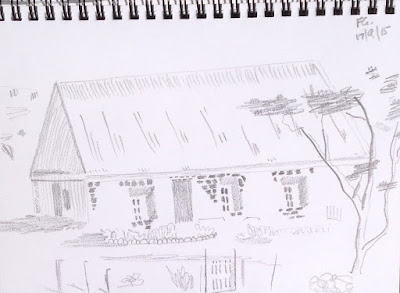Sketching this week
has included another effort to depict that house on the Chatham Islands that I tried in pastels in a previous post.
This time I tried a watercolour version:
And then for good measure a simple pencil sketch:
This morning, with the sun shining and the wind dropped, I set out early. My drivers licence expires in a few weeks, as happens every two years at my age, and I was headed for the AA office in town to renew it.
Fortunately the doctor had no qualms about Oking it last week so there was no problem.
A few metres from the AA building I stopped by a small reserve, named in honour of Sir Victor Davies, New Plymouth's leading horticulturalist of the last century, and sketched the view down the street. I was leaning on the brick wall and looking into the sunshine.
Among the inhabitants is this Yellow-crested Cockatoo, which kept saying "Hullo Charlie" the whole time I was sitting nearby sketching the scene.
When I left he farewelled me with "Bye-bye Charlie".
A short way away was the children's playground and behind that a large aviary with lots of exotic birds flying about.
I took a few more photos, including one of some of my colleagues. You can see more of the playground. The other sketchers are disguised as flax bushes!
Here is one of my sketches of the scene. The corner of the aviary is in the corner of my sketch. Unfortunately I was too far away to catch the birds!
Next time our meeting is going to concentrate on drawing crowds of people, basing our work on a seminar from the recent Sketching Symposium held in Singapore and reported on the internet.
So we are all going to be practising sketching body shapes and portraits.
Here is one I tried a few days ago from a photo in the newspaper.
I must keep practising so as to be ready for our meeting!
















